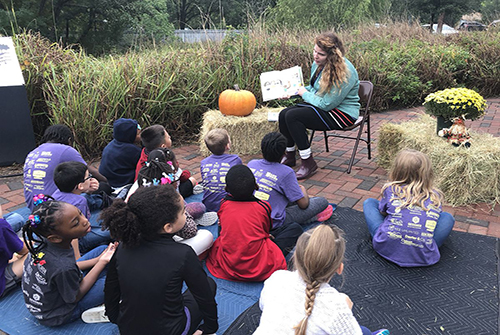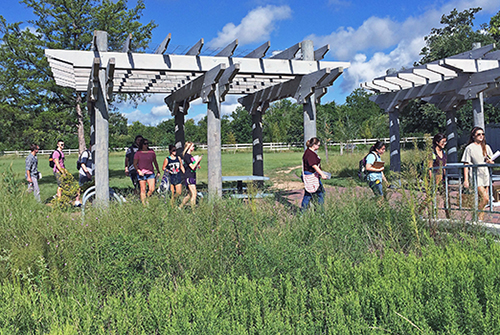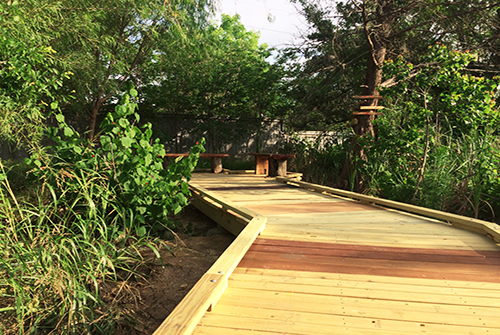Nestled in a quiet, peaceful neighborhood just two miles away from Texas A&M University is a 7-acre public park featuring picturesque pergolas, wandering walking trails and lush plant life. This is the Schob Nature Preserve, a gift from Dr. David Schob, a beloved Texas A&M history professor who died in 2007 and willed his land and a $1.9 million endowment to benefit the university.
Schob’s gift supports the Texas A&M Department of Landscape Architecture and Urban Planning in the College of Architecture as well as the Department of Recreation, Park and Tourism Sciences in the College of Agriculture and Life Sciences by providing an educational outdoor space and research site. This unique “living classroom”, co-managed by the two departments, gives students hands-on opportunities for design and research projects.
 The Schob Nature Preserve enjoys a partnership with the nearby College Hills Elementary school. The park has become a popular place to hold educational field trips and events, fulfilling Dr. David Schob's educational legacy.
The Schob Nature Preserve enjoys a partnership with the nearby College Hills Elementary school. The park has become a popular place to hold educational field trips and events, fulfilling Dr. David Schob's educational legacy.
In addition to its educational function, the park, which is located in the primarily residential College Hills neighborhood also serves as a gathering place for the surrounding community. Not far from the preserve is College Hills Elementary School, for which the park has become a popular area to hold events and educational field trips.
“Part of the intent of the preserve is to serve as a public park for the College Hills neighborhood,” said Eric Bardenhagen ’99, ’11 (PhD), associate department head of landscape architecture and urban planning. “This has certainly been successful. Most mornings and evenings, joggers can be seen using the looping pathways, neighbors can be found resting on a bench in one of the shaded seating areas, and children often attend school events at the park.”
Another part of Schob’s legacy is his former home, a three-bedroom, three-bathroom residence situated on a corner of the park, which is offered rent-free to a Texas A&M student or their family members who are active or former members of the U.S. military, law enforcement or fire protection services. The resident, known as a Schob Student Scholar, is responsible for the general oversight of the attached park and helps to coordinate the projects that take place there, as well as provide overall education on the site.
Justin Haug ’16, a former student who served in the U.S. Navy and a resident in 2014, credits the program with helping him earn his master’s degree in recreation, park and tourism sciences.
“It was one of the greatest gifts I’ve ever received,” he said. “When I enlisted in the Navy, I never thought I could get a bachelor’s degree, let alone a master’s degree. Dr. Schob’s appreciation for veterans and his support for their education provided me with the opportunity to turn fantasy into reality, and for that I will be forever grateful.”
 The Schob Nature Preserve provides a 7-acre educational outdoor space and research site for students in the Department of Landscape Architecture and Urban Planning and the Department of Recreation, Park and Tourism Sciences.
The Schob Nature Preserve provides a 7-acre educational outdoor space and research site for students in the Department of Landscape Architecture and Urban Planning and the Department of Recreation, Park and Tourism Sciences.
Haug, who went on to work for the National Park Service, is just one of the many students who has benefited from the residence.
“A previous Schob Scholar, who was a single mom and first responder, sought to take advantage of the opportunities she’d been given to get a master’s degree,” said Shannon Van Zandt ’93, department head of landscape architecture and urban planning. “She was struggling financially, so living at the Schob residence made earning a graduate degree possible for her. It is an amazing benefit to our students and serves as a way that we can give back to military or first responder families who have done so much for us.”
Along with the residence program, the preserve also supports a faculty Senior Schob Scholar, aiding faculty who use the preserve to pursue teaching, research, outreach activities and initiatives. These faculty members have been instrumental in the creation and development of the site and have contributed in numerous ways, making it the unique learning environment that it is today.
Bardenhagen, one of the current Senior Schob Scholars, has led many of the projects and events held on the preserve, including youth classes and the construction of a boardwalk. “The most rewarding thing about this position is the ability to bring students from Texas A&M and College Hills Elementary together,” he said. “The preserve functions as an amazing environmental education resource for elementary and college students, as well as offering research opportunities for faculty.”
Student Projects at the Preserve
Since the park’s dedication in 2014, landscape architecture professors and students have taken full advantage of Schob’s gift, participating in research and design projects that benefit both the students’ education and the park itself.
 The boardwalk, built as part of a research project during the spring 2017 semester, serves as a shaded area with a view of the rain gardens. The project allowed students to find out how weather affects the materials used on the boardwalk.
The boardwalk, built as part of a research project during the spring 2017 semester, serves as a shaded area with a view of the rain gardens. The project allowed students to find out how weather affects the materials used on the boardwalk.
In spring 2015, students designed the Rain Gardens, a system near the entrance of the park that helps manage storm water by slowly absorbing runoff from impermeable surfaces like sidewalks and parking lots. This example of “green infrastructure” includes an environmentally-friendly and sustainable way to filter storm water pollutants and reduce flooding.
The following fall semester, students focused on designing and installing a prairie habitat on a portion of the land, which attracts pollinators and birds and adds to the overall aesthetic value of the site. Signs were also created and placed around the site to teach visitors about other projects on the preserve and the native plant life.
The most recent project was the addition of a boardwalk in spring 2017. Students constructed the walkway and several benches in a shaded area with a view of the Rain Gardens. While it’s visually pleasing, the boardwalk was also a research project in which students tested and observed the structure’s various materials to learn how weather affects them.
“The departments are now in the beginning stages of creating a long-term master plan for the preserve,” said Bardenhagen. “We want to make sure we continue to honor Dr. Schob’s legacy through projects that benefit students and the community.”
The College of Architecture is celebrating its 50th anniversary as a college. To learn how you can support students and faculty through gifts to scholarships or programs, contact Larry Zuber, assistant vice president for development, at lzuber@txamfoundation.com or (979) 845-0939.